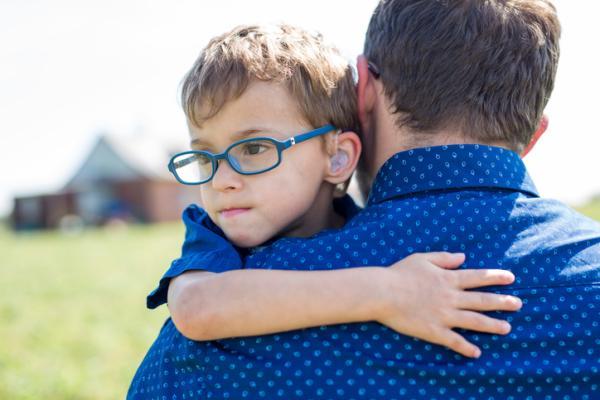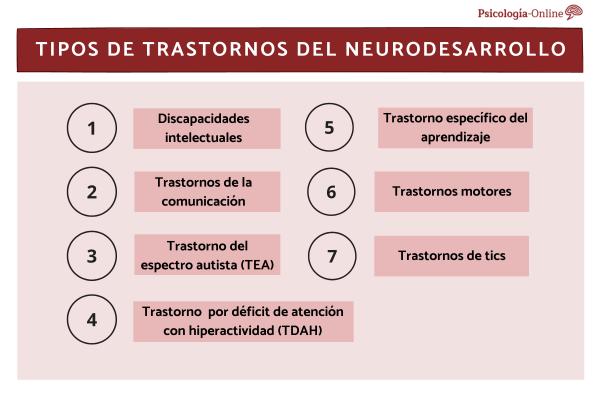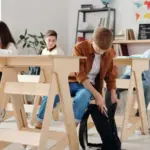It is likely that if your child has a disorder, it falls under neurodevelopmental disorders, since they are the ones most frequently diagnosed during childhood, although they can also be diagnosed in adolescence or adulthood.
If you notice that your child or yourself has difficulties or alterations in communication, many more difficulties than peers in reading, writing or mathematics, in carrying out a priori uncontrollable motor movements, difficulties in concentration, impulsivity and hyperactivity and difficulties in interact with others it is very possible that you have a neurodevelopmental disorder. In this PsychologyFor article, we will tell you what the types of neurodevelopmental disorders most common, what symptoms each of them presents and what is the best treatment in each case.
What are developmental disorders?
According to the APA (american psychiatric association)(1)Developmental disorders are a group of neurologically based disorders that they start during the period of childhood development. They often appear before the boy or girl begins school. As a consequence, this produces deficiencies in the school, social, academic or occupational sphere.
Intellectual disabilities
The symptoms manifested by people with intellectual disabilities are the following:
- Deficit in reasoning.
- Difficulties in problem solving and planning.
- Difficulties in abstract thinking and making judgments
- Difficulties in academic learning and from experiences.
- Score below an IQ of 70 on standardized intelligence tests.
- Difficulties in meeting sociocultural standards.
- Adaptive deficit that limits functioning in one or more activities of daily living: communication, social participation and independent living.
Treatment of intellectual disabilities
The treatment of neurodevelopmental disorders varies depending on the symptoms and characteristics of each individual. In this case, the first thing is to carry out secondary prevention, that is, start the intervention as soon as possible. Early detection is very important of intellectual disabilities to prevent the appearance of associated pathologies, achieve functional improvements and enable an adaptive adjustment to the person and their environment.
Specifically, in cases of intellectual disability, the intervention has two main strategies:
- Individualized planning (IP) support : The person’s needs will be evaluated and the desired goals and life experiences will be identified. The individualized plan will then be developed and implemented. Finally, this will be supervised and under constant evaluation to be able to make the necessary modifications. In these cases, we can find everything from PI in schools, adapting the curriculum to the needs of the child, to external reinforcements such as re-education to improve their intellectual abilities.
- Person-centered planning : is a collaborative process to help the person access the supports and services they need to achieve a higher quality of life based on their own preferences and values with the following primary objectives:
- Be present and participate in life in the community.
- Maintain and create links of satisfactory relationships.
- Express preferences and make decisions in everyday life activities.
- Have the opportunity to develop activities with social recognition and live with dignity.
- Continue developing personal skills.

Communication disorders
There are multiple communication disorders, so their symptoms will vary depending on each specific disorder. In general terms, the most frequent symptoms of communication disorders are:
- Difficulties in aspects of production, mainly in motor function.
- Late appearance of language.
- Dislalias.
- Motor alteration that involves the bucophonatory organs.
- Difficulties in sound production due to some anatomical alteration of the oral apparatus.
- Dysphemia or stuttering.
- Impaired language comprehension.
- Massive creep inability.
- Hardly intelligible speech.
- Difficulty evoking words.
- Difficulties in communication skills.
- Difficulties in constructing sentences or speech in general.
When treating this type of neurodevelopmental disorder, you must go to a speech therapist. The objective is offer tools to the boy or girl to communicate despite their difficulties and work on the specific aspects that are altered. Additionally, there are some treatments, such as the Hanen program, that teach parents how to improve their children’s language skills.
Autism spectrum disorder (ASD)
People with autism spectrum disorder present the following symptoms:
- Qualitative alterations in social interaction.
- Difficulties in emotional reciprocity.
- Qualitative alterations in communication.
- Presence of stereotyped language.
- Limitation in symbolic play.
- Restricted, repetitive and stereotyped behavior patterns.
Treatment of autism spectrum disorder
Intervention programs for the treatment of ASD include theories based on evolutionary and developmental psychology, as well as learning and behavior modification. We highlight the following recommendations:
- Treatment should be started as soon as possible.
- Implement psychoeducational programs of a certain intensity (15-20 hours a week when the boy or girl is low functioning).
- Train parents and/or direct caregivers.
- Set work objectives aimed at functionality, seeking to generate learning in different contexts and people.
- Provide academic support.
- Work on communication difficulties.
- Train social skills.
- Promote personal autonomy.
- Reduce behavioral problems with parent training.

Attention deficit hyperactivity disorder (ADHD)
Within neurodevelopmental disorders we also find attention deficit hyperactivity disorder (ADHD). The main symptoms of this condition are:
- Attention difficulties.
- Impulsiveness.
- Hyperactivity.
If you want to know more about this disorder and its symptoms in more detail, consult the following articles on ADHD in children and ADHD in adults.
ADHD treatment
The most efficient ADHD treatment is a multimodal treatment or multidisciplinary that combines pharmacological, psychological and psychopedagogical therapy. Therefore, it is important to address the following aspects:
- Psychoeducation of the disorder and/or associated disorders or problems.
- Training parents to manage their children’s behavior, either individually or in a group.
- Psychological intervention aimed at the boy or girl.
- Application of cognitive-behavioral techniques in recreational environments.
- Working memory training.
- School intervention, making the pertinent adaptations.
- Psychopedagogical intervention treating associated deficits, as well as study, organization and planning strategies and techniques.
- Pharmacotherapy.
Specific learning disorder
The characteristic symptoms of specific learning disorder are:
- Dyslexia : difficulties in reading and writing. In this article, we show you exercises to detect dyslexia.
- Dyscalculia : difficulties in mathematics.
- Nonverbal learning disorder : alteration of some motor functions, difficulty perceiving and organizing visual information, social interaction problems, lack of awareness of time, difficulties in pragmatic aspects of language and visible academic repercussions, especially in graphics, reading, mathematics , plastic and physical education.
Treatment of specific learning disorder
Treatment will vary substantially depending on the learning disorder we intend to treat. Generally, there is adaptations at school and work with re-education with the aim of compensating for the difficulties associated with each particular disorder and enhancing strengths. Let’s see how to focus treatment depending on the type of learning disorder you have:
- Dyslexia : It is important to make school adaptations and good re-education in reading and writing with the aim of improving mechanical reading, although if the child is already in the last cycle of school age, the objective should be to look for compensatory strategies. The re-education of writing will be aimed at avoiding making phonological or spelling errors. In this article you will see how to help a child with dyslexia.
- Dyscalculia : carry out re-education with the aim of reinforcing logical reasoning. Do not focus only on the abilities and skills related to problem solving and mathematical operations, but you also have to work on the concept of number, serializations, classifications, equalization, use of work strategies and practice.
- Nonverbal learning disorder : You have to work on self-esteem, in addition to the abilities and skills in which it is most difficult.

Motor disorders
Another group of very common neurodevelopmental disorders are motor disorders. The symptoms of this type of conditions It is usually the following.
- Alterations in coordination.
- Repetitive motor behaviors: hand waving, body rocking, head banging, biting, or hitting.
- Deficits in the execution and acquisition of motor skills.
- Clumsiness, slowness or inaccuracy in the execution of the movement.
The treatment of motor disorders must be carried out by a physiotherapist in coordination with other professionals that he or she deems appropriate.
Tic disorders
Tic disorders are one of the most common groups of neurodevelopmental disorders in which the following symptoms manifest:
- Presence of simple motor tics : blinking, winking, facial grimacing, movements of the nose or mouth, movements of the head, raising of the shoulders or twitching of the limbs.
- Presence of complex motor tics : touching objects or people, taking a step back, simultaneously extending arms and legs, making obscene or socially inappropriate gestures or repeating the movement observed in another person.
- Presence of simple phonic tics : throat clearing, cough, nasal inhalation or guttural sound.
- Presence of complex phonic tics : repeating the last word or phrase spoken by another person, repeating the same word or phrase repeatedly, verbalizing obscene or socially inappropriate words, changing the accent or intonation of the speech.
The best treatment for tic disorders is psychoeducation and symptom monitoring , followed by specific treatment of comorbid disorders and training in habit reversal and exposure technique and response prevention as psychological techniques. Ultimately, pharmacological treatment can be performed and, if this does not work either, deep brain stimulation will have to be applied.

This article is merely informative, at PsychologyFor we do not have the power to make a diagnosis or recommend a treatment. We invite you to go to a psychologist to treat your particular case.
If you want to read more articles similar to Types of neurodevelopmental disorders we recommend that you enter our Clinical Psychology category.
- American psychiatric association, (2014). Diagnostic and Statistical Manual of Mental Disorders DSM – 5. Madrid Spain. Pan-American medical publishing house.
Bibliography
- Ezpeleta, L. and Toro, J. (coords.) (2016). Developmental psychopathology. Madrid: Ed. Pirámide.









